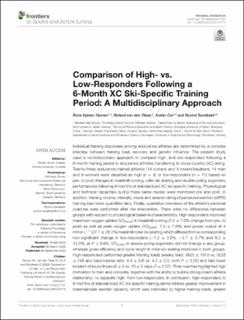| dc.contributor.author | Kjøsen Talsnes, Rune | |
| dc.contributor.author | van den Tillaar, Roland | |
| dc.contributor.author | Cai, Xudan | |
| dc.contributor.author | Sandbakk, Øyvind | |
| dc.date.accessioned | 2021-02-24T12:22:47Z | |
| dc.date.available | 2021-02-24T12:22:47Z | |
| dc.date.created | 2020-09-06T16:06:27Z | |
| dc.date.issued | 2020 | |
| dc.identifier.citation | Talsnes, R. K., van den Tillaar, R., Cai, X. & Sandbakk, Ø. (2020). Comparison of high-versus low-responders following a 6-month XC ski-specific training period: a multidisciplinary approach. Frontiers in Sports and Active Living, 2: 114. doi: | en_US |
| dc.identifier.issn | 2624-9367 | |
| dc.identifier.uri | https://hdl.handle.net/11250/2730103 | |
| dc.description.abstract | Individual training responses among endurance athletes are determined by a complex interplay between training load, recovery and genetic influence. The present study used a multidisciplinary approach to compare high- and low-responders following a 6-month training period in endurance athletes transferring to cross-country (XC) skiing. Twenty-three endurance-trained athletes (14 runners and 9 rowers/kayakers; 14 men and 9 women) were classified as high (n = 9) or low-responders (n = 11) based on pre- to post changes in treadmill running, roller-ski skating and double-poling ergometry performances following 6-months of standardized XC ski-specific training. Physiological and technical capacities during these same modes were monitored pre and post. In addition, training volume, intensity, mode and session rating of perceived exertion (sRPE) training load were quantified daily. Finally, qualitative interviews of the athlete's personal coaches were performed after the intervention. There were no differences between groups with respect to physiological baseline characteristics. High-responders improved maximum oxygen uptake (VO2max) in treadmill running (5.5 ± 7.0% change from pre- to post) as well as peak oxygen uptake (VO2peak; 7.3 ± 7.0%) and power output at 4 mmol·L−1 (37.7 ± 28.2%) treadmill roller-ski skating which differed from a corresponding non-significant change in low-responders (−1.2 ± 3.6%, −2.7 ± 3.7% and 8.2 ± 12.5%; all P ≤ 0.05). VO2peak in double-poling ergometry did not change in any group, whereas gross efficiency and cycle length in roller-ski skating improved in both groups. High-responders performed greater training loads (weekly load: 3825 ± 1013 vs. 3228 ±.748 and load/volume ratio: 4.9 ± 0.6 vs. 4.2 ± 0.5; both P ≤ 0.05) and had lower incident of injury/illness (5 ± 3 vs. 10 ± 5 days; P = 0.07). Their coaches highlighted high motivation to train and compete, together with the ability to build a strong coach-athlete relationship, to separate high- from low-responders. In conclusion, high-responders to 6-months of standardized XC ski-specific training demonstrates greater improvement in maximal/peak aerobic capacity, which was coincided by higher training loads, greater perceived effort during sessions and lower incidents of injury and illness in comparison to their lower-responding counterparts. Possibly, the higher motivation and stronger coach-athlete relationships in high-responders contributed to more individually optimized training and recovery routines, and thereby more positive performance-development. | en_US |
| dc.language.iso | eng | en_US |
| dc.publisher | Frontiers | en_US |
| dc.rights | Navngivelse 4.0 Internasjonal | * |
| dc.rights.uri | http://creativecommons.org/licenses/by/4.0/deed.no | * |
| dc.title | Comparison of high-versus low-responders following a 6-month XC ski-specific training period: a multidisciplinary approach | en_US |
| dc.type | Peer reviewed | en_US |
| dc.type | Journal article | en_US |
| dc.description.version | publishedVersion | en_US |
| dc.rights.holder | © 2020 The Author(s) | en_US |
| dc.subject.nsi | VDP::Samfunnsvitenskap: 200::Samfunnsvitenskapelige idrettsfag: 330 | en_US |
| dc.subject.nsi | VDP::Medisinske Fag: 700::Idrettsmedisinske fag: 850 | en_US |
| dc.source.volume | 2 | en_US |
| dc.source.journal | Frontiers in Sports and Active Living | en_US |
| dc.identifier.doi | 10.3389/fspor.2020.00114 | |
| dc.identifier.cristin | 1827573 | |
| dc.relation.project | Norges forskningsråd: 298645 | en_US |
| dc.description.localcode | Unit Licence Agreement | en_US |
| dc.source.articlenumber | 114 | en_US |

